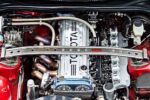Chevy 5.3 Engine Interchange Problems
A Brief History
The Chevy 5.3 engine, part of General Motors’ LS family, has been a staple in the automotive world since its introduction in the late 1990s. Initially designed for trucks and SUVs, this engine quickly gained popularity due to its balance of power and efficiency. With a displacement of 5.3 liters, it offers a robust performance that appeals to both casual drivers and enthusiasts alike. Over the years, the 5.3 has been utilized in various models, including the Chevrolet Silverado, Tahoe, and GMC Sierra, among others.
As the years progressed, the 5.3 engine underwent several revisions, leading to variations in design, components, and technology. This evolution has resulted in a diverse range of engines that, while sharing a common lineage, can present significant interchange issues. Mechanics and DIY enthusiasts often face challenges when attempting to swap or replace parts between different model years or engine variants.
The interchange problems stem from a variety of factors, including changes in engine management systems, sensor placements, and even physical dimensions. These discrepancies can lead to compatibility issues that complicate repairs and modifications. Understanding these challenges is crucial for anyone working with the Chevy 5.3 engine, whether for routine maintenance, performance upgrades, or complete engine swaps.
In this article, we will delve into the specific interchange problems associated with the Chevy 5.3 engine, exploring the nuances that can make or break a successful engine swap. By highlighting the critical aspects of compatibility and offering insights into potential pitfalls, we aim to equip readers with the knowledge needed to navigate the complexities of the Chevy 5.3 engine interchange landscape.
Understanding Chevy 5.3 Engine Interchange Problems
The Chevy 5.3 engine has become synonymous with reliability and performance, but its interchangeability can be a minefield for those looking to replace or upgrade components. Various factors contribute to these issues, making it essential to understand the nuances involved.
Common Interchange Issues
When dealing with the Chevy 5.3 engine, several common interchange problems arise:
- Engine Variants: The 5.3 engine has multiple variants, including the LM7, L59, and L33, each with specific features that may not be compatible with one another.
- Year Differences: Changes made from one model year to the next can affect everything from wiring harnesses to mounting points.
- Sensor Locations: Variations in sensor placements can lead to significant issues when swapping engines or components.
- ECU Compatibility: The engine control unit (ECU) may require reprogramming or replacement to work with different engine variants.
Key Components Affected
Several key components are particularly susceptible to interchange issues:
- Intake Manifold: The design and fitment of intake manifolds can vary significantly between engine variants.
- Exhaust Manifold: Exhaust manifold configurations may differ, affecting fitment and exhaust flow.
- Oil Pan: The oil pan shape and mounting points can change, leading to potential leaks or fitment issues.
- Wiring Harness: Different years and variants may have unique wiring harnesses, complicating swaps.
Symptoms of Interchange Problems
When attempting to interchange parts or engines, certain symptoms may indicate compatibility issues. Recognizing these signs can save time and resources:
| Symptom | Possible Consequence |
|---|---|
| Check Engine Light | Faulty sensors or ECU incompatibility |
| Poor Engine Performance | Improperly matched components |
| Oil Leaks | Incorrect oil pan fitment |
| Exhaust Noise | Misaligned exhaust components |
| Electrical Issues | Wiring harness mismatches |
Conclusion
Understanding the Chevy 5.3 engine interchange problems is vital for anyone looking to work on these engines. By being aware of the common issues and symptoms, you can better navigate the complexities of engine swaps and repairs.
Or open the survey in a new tab: Take the Survey




0 Comments